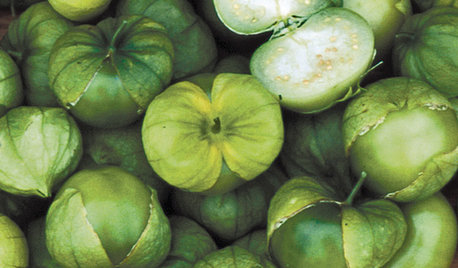Tomatillos ( Tomato Tree)
ifraser25
14 years ago
Related Stories

SUMMER FRUITS AND VEGETABLESSummer Crops: How to Grow Tomatillos
Grow this Mexican native for the freshest salsa verde — and for fewer problems than its tomato cousins
Full Story0

EDIBLE GARDENSSummer Crops: How to Grow Tomatoes
Plant tomato seedlings in spring for one of the best tastes of summer, fresh from your backyard
Full Story
LIFEKitchen Traditions: Tomato Season Meets a Family Legacy
Somewhere a Sicilian great-great-grandmother is smiling at a bowl of American-made sauce
Full Story
EDIBLE GARDENSHow to Add an Apple Tree to Your Edible Garden
Readily available, beautiful and fragrant, apple trees offer four-season interest along with crisp, juicy fruit
Full Story
HOUZZ TOURSHouzz Tour: Eclectic Chilean Home Embraces Trees
Ficus trees star in the interior courtyard of this Santiago house, which celebrates its design history, quirks and mix of styles
Full Story
THE ART OF ARCHITECTUREWorld of Design: Trees Bring Nature to a High-Rise in Milan
Discover ‘the most beautiful and innovative skyscraper in the world’ — the foliage-filled Bosco Verticale — and tour one of its apartments
Full Story
FRUIT TREESHow to Grow Your Own Persimmons
Sturdy and easy to care for, these trees offer bright fruit through winter — and keeping them in bounds is no sweat
Full Story
FARM YOUR YARDHouzz Call: Home Farmers, Show Us Your Edible Gardens
We want to see where your tomatoes, summer squashes and beautiful berries are growing this summer
Full Story
GARDENING GUIDESCalifornia Gardener's June Checklist
Update your hydrangeas, catch up on tomatoes and more ways to enjoy your California garden in June
Full Story
HOUZZ TOURSMy Houzz: Country-Chic Dutch Family Home
An organizer lightens up a dark 1970s farmhouse on a Netherlands tomato farm with open space and soothing shades of gray
Full StoryMore Discussions







wordwiz
digdirt2
Related Professionals
Arnold Landscape Architects & Landscape Designers · Clark Landscape Architects & Landscape Designers · Foothill Ranch Landscape Architects & Landscape Designers · Milwaukee Landscape Architects & Landscape Designers · Port Royal Landscape Architects & Landscape Designers · Edmond Landscape Contractors · Maple Valley Landscape Contractors · Harvey Landscape Contractors · North Lauderdale Landscape Contractors · Oak Forest Landscape Contractors · Ocoee Landscape Contractors · Point Pleasant Landscape Contractors · West Palm Beach Landscape Contractors · Lauderdale Lakes Landscape Contractors · Anaheim Driveway Installation & Maintenancemrswaz
alabamanicole
jimster
calliope
Belgianpup
jimster
greenthumbsj
cyrus_gardner
alabamanicole
digdirt2
denninmi
alabamanicole
neohippie
jimster
jimster
denninmi
alabamanicole
whgille
cyrus_gardner
susancol
jimster
denninmi
whgille
cyrus_gardner
toils-in-soils